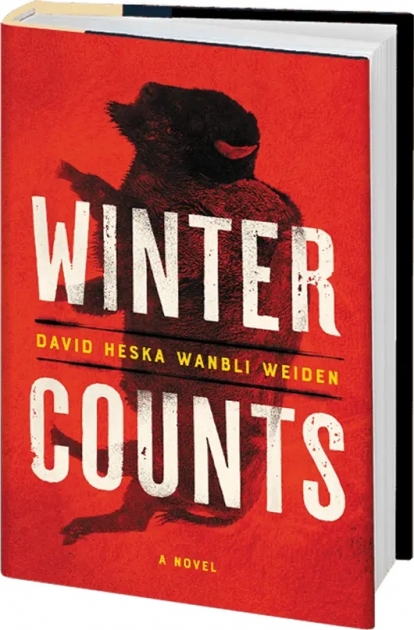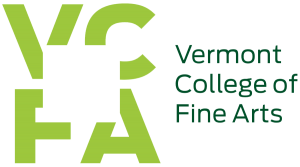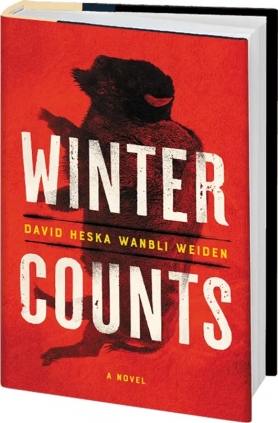David Weiden at VCFA
Program Awesomeness
 One of the best things about The Writing & Publishing program here at VCFA is the amazing visiting writers that come to speak and to teach modules. David Heska Wanbli Weiden is just such a person.
One of the best things about The Writing & Publishing program here at VCFA is the amazing visiting writers that come to speak and to teach modules. David Heska Wanbli Weiden is just such a person.
Although he started his MFA right here at VCFA, he completed it at the Institute of American Indian Arts. He also holds a law degree and a PhD. He’s a Tin House Scholar, a MacDowell Fellow, and a PEN/America Writing for Justice Fellow.
David is the author of Spotted Tale, a children’s book that tells the story of the Lakota leader of the same name. This book was awarded the 2020 Spur Awa rd by the Western Writers of America. He’s been published in the New York Times, Shenandoah, Yellow Medicine Review, Transmotion, Criminal Class Review, Tribal College Journal and many more.
rd by the Western Writers of America. He’s been published in the New York Times, Shenandoah, Yellow Medicine Review, Transmotion, Criminal Class Review, Tribal College Journal and many more.
David’s known mostly for writing crime fiction, so it makes sense that the module he taught was called “Techniques in Genre Literature.” The overarching theme of the class was that the borders between genre and literary fiction are fading, and that many genre techniques can be used to make any writing better. As an example, he taught us an outlining technique that comes from screenwriting. To say it’s the best outlining technique I’ve learned would be an understatement. It is, in fact, the only outlining technique I’ve been taught in my six years as a Creative Writing major. (I thought that would’ve come in my first creative writing class, but no.) He also taught techniques such as “varying your beginnings throughout your novel”, “ending a chapter on a cliffhanger, but use cliffhangers sparingly”, and “the best villains are a dark mirror of the protagonist.” These are techniques that work!
Winter Counts
 Weiden’s debut novel Winter Counts dropped in late August and is a New York Times Book Review’s Editor’s choice. Publisher’s Weekly has named it one of the Best Books of 2020. It’s gotten rave reviews from the New York Times, Publishers Weekly, The Washington Post, the Los Angeles Times, The Denver Post, USA Today, The San Francisco Chronicle, Air Mail, Crime Time, Mystery Scene, the South Florida Sun Sentinel, among others. During our craft module with David it was announced that Winter Counts is the BuzzFeed Book Club’s November pick.
Weiden’s debut novel Winter Counts dropped in late August and is a New York Times Book Review’s Editor’s choice. Publisher’s Weekly has named it one of the Best Books of 2020. It’s gotten rave reviews from the New York Times, Publishers Weekly, The Washington Post, the Los Angeles Times, The Denver Post, USA Today, The San Francisco Chronicle, Air Mail, Crime Time, Mystery Scene, the South Florida Sun Sentinel, among others. During our craft module with David it was announced that Winter Counts is the BuzzFeed Book Club’s November pick.
Plot Summary
In the opening scene Virgil Wounded Horse lays in wait for a teacher, Guv Yellowhawk, from the reservation school. When Yellowhawk, emerges from the local tavern, Virgil pounces and pounds, leaving the teacher bloody and bruised, with several broken bones. This might lead us to believe that Virgil is the villain and Yellowhawk a poor hapless victim. We’d be wrong. Yellowhawk has raped one of his students, a 9 year-old girl.
Virgil is the reservation’s enforcer, and he has waived his fee for this job.
Soon Virgil is offered another job that he’s not sure he wants to take. Heroin has been showing up on the Rez, and people are dying. Tribal Councilman, Ben Short Bear, wants Virgil to go after a member of the tribe he suspects of bringing in the drugs. The suspect turns out to be Rick Crow, Virgil’s nemesis from high school. Crow was a bully, a full blood who never let Virgil forget he was Iyeska, a half breed. While it would be satisfying for Virgil to bring Crow to justice–and the money is great–something just doesn’t feel right, so he turns down the job.
Then Virgil’s nephew overdoses on heroin, causing him to change his mind.
Winter Counts has what it takes to keep mystery and crime fiction lovers happy: twists and turns, dead-ends, the reddest of red herrings and an ending that will have readers slapping their foreheads, while still leaving them satisfied.
But Winter Counts is more than a crime novel.
This is a story about identity and belonging and finding one’s way and place in the world. The book shows Rez life without any of the usual overblown stereotypes. Heska Wanbli Weiden knows this world intimately. As an enrolled member of the Sicangu Lakota tribe, it’s the world he grew up in, the Rosebud Indian Reservation of South Dakota.
On NDN-ness
I ate this novel up. I am enrolled Delaware of Oklahoma, who’s never even been on a reservation. My tribe doesn’t live on one, and, frankly, I was raised in Los Angeles. I never met an NDN who wasn’t part of my immediate family until my mid-twenties. To read about life among a tribe was fascinating to me, especially without stereotypes.
There was so much I could relate to, from the music, (early 80s punk rock to 90s metal)(and how much did I love the pun of including Siouxsie and the Banshees in this list? Especially when we readers learn that Sioux is not an indigenous name but is what French trappers called these tribal people during the Westward Expansion. And that it means “snake.”) to the way white people see us natives; to the way we are told to speak about our own “Indian-ness.” (“I believe they like to be called Native American,” says the white, dreadlocked doctor at the pot-shop to Virgil and his girlfriend Marie.) (This had me cackling in my dorm room. That exact thing has been said to me, and just about every NDN I know!)
But then, of course, the novel told of aspects of being indigenous that I know very little about. The spirituality, elders with advice, going to the spirits to gain guidance and direction. And, just plain old life on the Rez, which tends towards poverty and despair. This novel is gritty, and real, with the plight of poverty and crime as stark and powerfully portrayed as the traditions and spirituality. Winter Counts is about reconciling past with present and paving the way for the future.
I highly recommend Winter Counts. I also recommend taking a class or workshop with David at your first opportunity.Running sneakers | Nike Shoes

